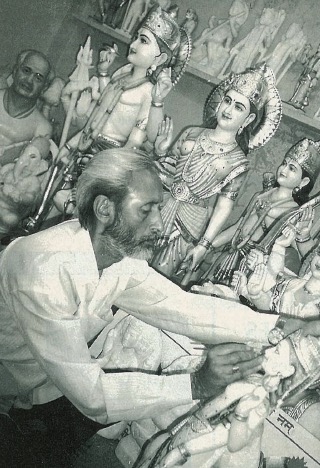By Lavina Melwani
Where would you find Siva lost in samadhi, Krishna playing His flute and Ganesha feasting on sweets? In Jaipur’s Khajanewalon ka Rasta–The Lane of Treasures. It is the alternative Vaikunta (heaven), the Gods’ earthly abode. This winding lane of thousands of marble shops has every deity from the Hindu pantheon and more Gods and Goddesses per square meter than any place in the world.
I got a chance to visit this surreal marketplace quite by serendipity. My younger sister was setting up a temple in the garden of her Delhi home and on earlier visits to Jaipur had scoured the lanes and bylanes of Khajanewalon ka Rasta for the most loving images of her favorite Gods. As she was leaving, she came across a rare statue of Ardhanariswara–half Siva, half Shakti, which combines the potent energies of both. This marble idol has both male and female aspects–Siva’s matted locks, serpent necklace and hermit’s clothing merging with the sari and jewels on the female side.
Since the statue had not yet been painted, my sister had decided she would buy it on a later visit. The only problem now was that she had misplaced the address. How could she find it in the maze of thousands of shops? She was, however, confident that she would find Him–or He would find her.
Rajasthan is studded with cities, towns and villages excelling in arts and crafts, and Jaipur is certainly its crown jewel. Rajasthan has had skilled artisans working in brass, stone, clay, wood, ivory, silver, gold, marble, leather and textiles for hundreds of years.
The kings and noblemen of Rajasthan were avid patrons of the arts and had always encouraged their craftspeople, and the people of this dusty, desert kingdom seemed to thirst for art. Everything from their homes to the howdahs of their elephants were elaborately decorated. The Govind Devji temple was built in such a fashion that the king could see the God from the Chandra Mahal (Moon Hall) which is exactly opposite to it.
The talents of the traditional marble carvers can be seen in the newly-built Laxmi Narain temple just outside the Pink City in Moodi Doongri. Having seen many of these marvels, we returned to the Lane of Treasures to find our own marble treasure.
We followed Jaipur’s bustling tributary of lanes, each specializing in a certain craft. In Ramganj Bazaar, one can see workers creating leather shoes. Kishanpol Bazar has tie dye textiles, and lac items can be found in Maniharon ka Rasta.
Marble craft drives the economy of Khazanewalon ka Rasta. Here are hundreds of showrooms and workshops spread like a patchwork quilt along the narrow lane. Every showroom is bursting with hundreds of Gods. Next to them, the humans look small and puny as they chisel on the gigantic statues, coaxing Godly graces out of the white stone. The marble comes from the mines of Markana which also provided the material for the Taj Mahal.
In the back rooms one can see packing materials and boxes, for a great many of these icons are part of a thriving export trade to foreign lands. As the immigrant population with Indian roots has grown in many parts of the world, a demand has been created for marble deities in the temples which are opening in many parts of the Far East, the U.S. and Europe.
As the hours ticked away in the heat of the Khazonwalon ka Rasta, we still had not found the God we were hunting for. We had to take off our shoes every time we entered a shop with Gods, Goddesses and holy men; every shop had Ganeshas, Krishnas and even Guru Nanak–but no Ardhanariswara. Toward day’s end we reached one of the last shops with very little hope. There sat the Ardhanarishwara in a corner. Partially painted, it was waiting for my sister. The shopkeepers smiled. They knew my sister would find them–or Ardhanariswara would find her.
The tourist guide book advises one “to bargain every step and not to put on a defeatist attitude.” But my sister, an avid negotiator, just could not bring herself to haggle in this hallowed store. She asked, “How can I bargain for God?”
My sister was delighted, immediately bonding with the figurine. The shop’s icons painter, former muncipal worker Ratan Chand, a lean man with a white beard, is today court artist to the Gods. As is the custom here, the face are not painted until the piece is sold. He immediately started the finishing touches asking, us to return after some time. When we came back, he put the traditional final touch on the eyes and there before us Ardhanariswara’s stony face was transformed into mystic, beatific glow. The peerless He/She was ready to return with us to our garden temple home.
